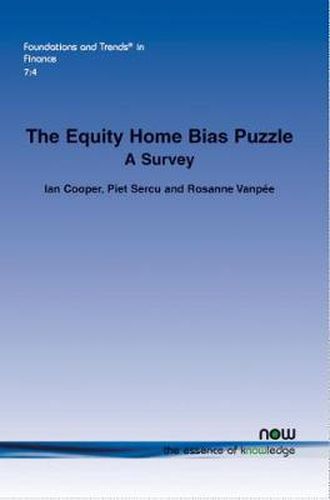Readings Newsletter
Become a Readings Member to make your shopping experience even easier.
Sign in or sign up for free!
You’re not far away from qualifying for FREE standard shipping within Australia
You’ve qualified for FREE standard shipping within Australia
The cart is loading…






This title is printed to order. This book may have been self-published. If so, we cannot guarantee the quality of the content. In the main most books will have gone through the editing process however some may not. We therefore suggest that you be aware of this before ordering this book. If in doubt check either the author or publisher’s details as we are unable to accept any returns unless they are faulty. Please contact us if you have any questions.
The Equity Home Bias Puzzle: A Survey puts into perspective one of the strongest and most persistent empirical phenomena in finance: equity home bias. The authors not only provide a thorough review of the competing Measures of home bias and the explanations for the equity home bias proposed in the current literature, but also lay out the implications of international under-diversification for portfolio formation and the cost of capital of companies.
The Equity Home Bias Puzzle: A Survey is organized as follows. After an introduction, Section 1 defines the equity home bias puzzle and explains why it is important. Section 2 reviews the two main methods used to quantify equity home bias, the positive and normative approaches, and shows how alternative home bias Measures can be constructed using variations or combinations of these two methods. In Section 3 the authors explain the economic significance of under-diversification by estimating the total implied discount and then go on to review the various explanations for equity home bias-ultimately concluding that each explanation on its own is not sufficient, suggesting, in Section 4, that equity home bias reflects a combination of factors. Section 5 lays out the implications of home bias for investment and corporate finance and Section 6 concludes that no version of standard portfolio theory alone has been able to explain it.
$9.00 standard shipping within Australia
FREE standard shipping within Australia for orders over $100.00
Express & International shipping calculated at checkout
Stock availability can be subject to change without notice. We recommend calling the shop or contacting our online team to check availability of low stock items. Please see our Shopping Online page for more details.
This title is printed to order. This book may have been self-published. If so, we cannot guarantee the quality of the content. In the main most books will have gone through the editing process however some may not. We therefore suggest that you be aware of this before ordering this book. If in doubt check either the author or publisher’s details as we are unable to accept any returns unless they are faulty. Please contact us if you have any questions.
The Equity Home Bias Puzzle: A Survey puts into perspective one of the strongest and most persistent empirical phenomena in finance: equity home bias. The authors not only provide a thorough review of the competing Measures of home bias and the explanations for the equity home bias proposed in the current literature, but also lay out the implications of international under-diversification for portfolio formation and the cost of capital of companies.
The Equity Home Bias Puzzle: A Survey is organized as follows. After an introduction, Section 1 defines the equity home bias puzzle and explains why it is important. Section 2 reviews the two main methods used to quantify equity home bias, the positive and normative approaches, and shows how alternative home bias Measures can be constructed using variations or combinations of these two methods. In Section 3 the authors explain the economic significance of under-diversification by estimating the total implied discount and then go on to review the various explanations for equity home bias-ultimately concluding that each explanation on its own is not sufficient, suggesting, in Section 4, that equity home bias reflects a combination of factors. Section 5 lays out the implications of home bias for investment and corporate finance and Section 6 concludes that no version of standard portfolio theory alone has been able to explain it.